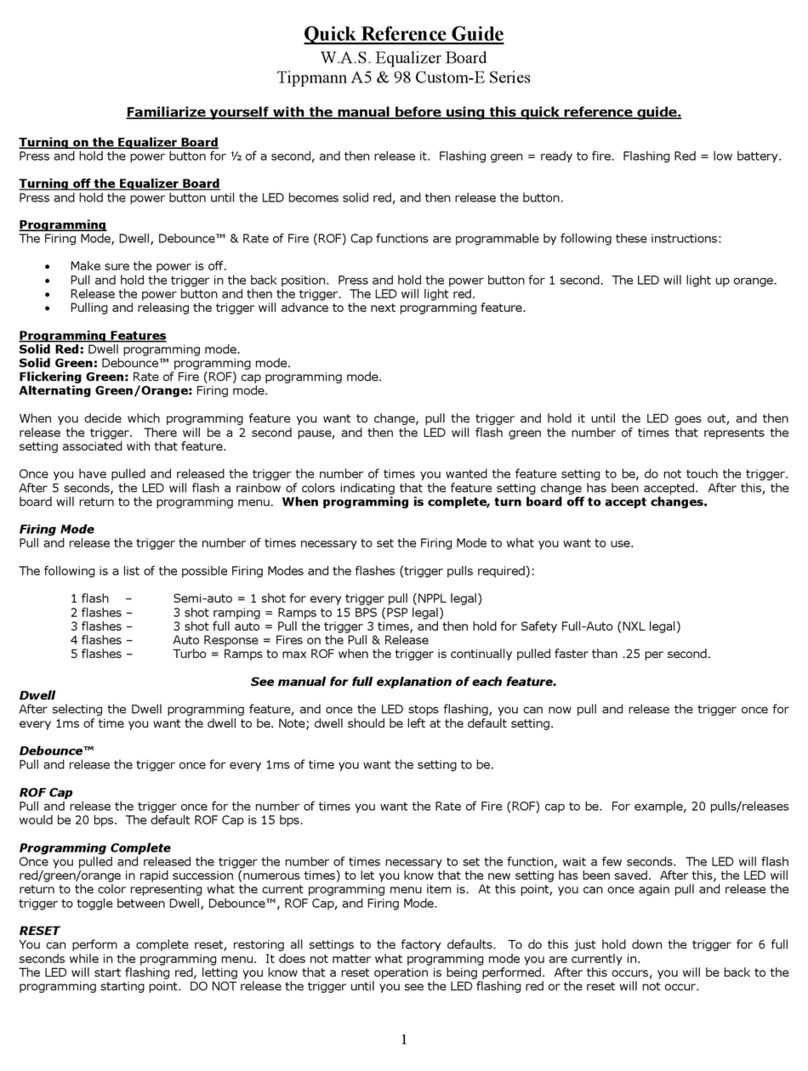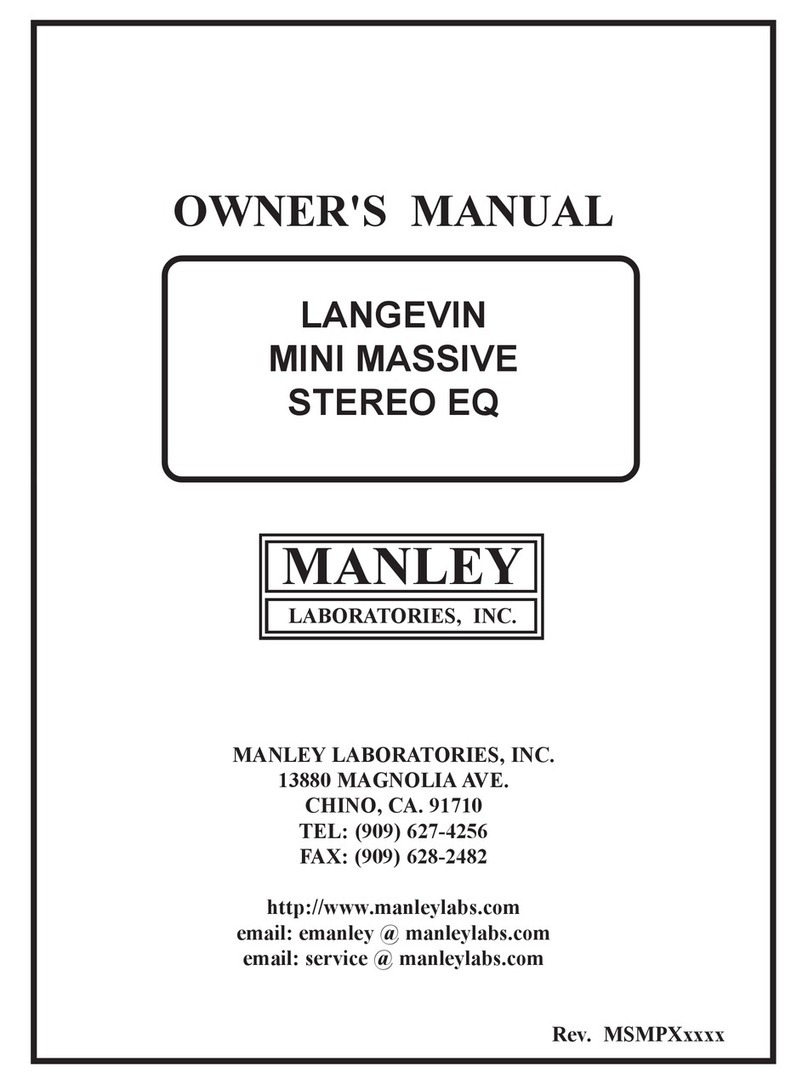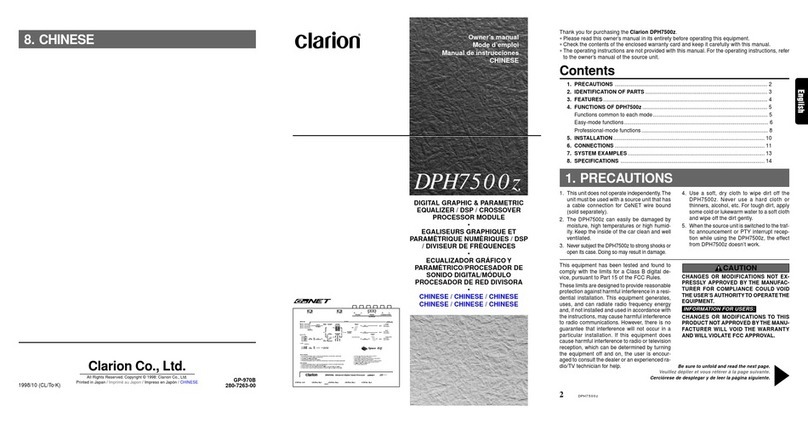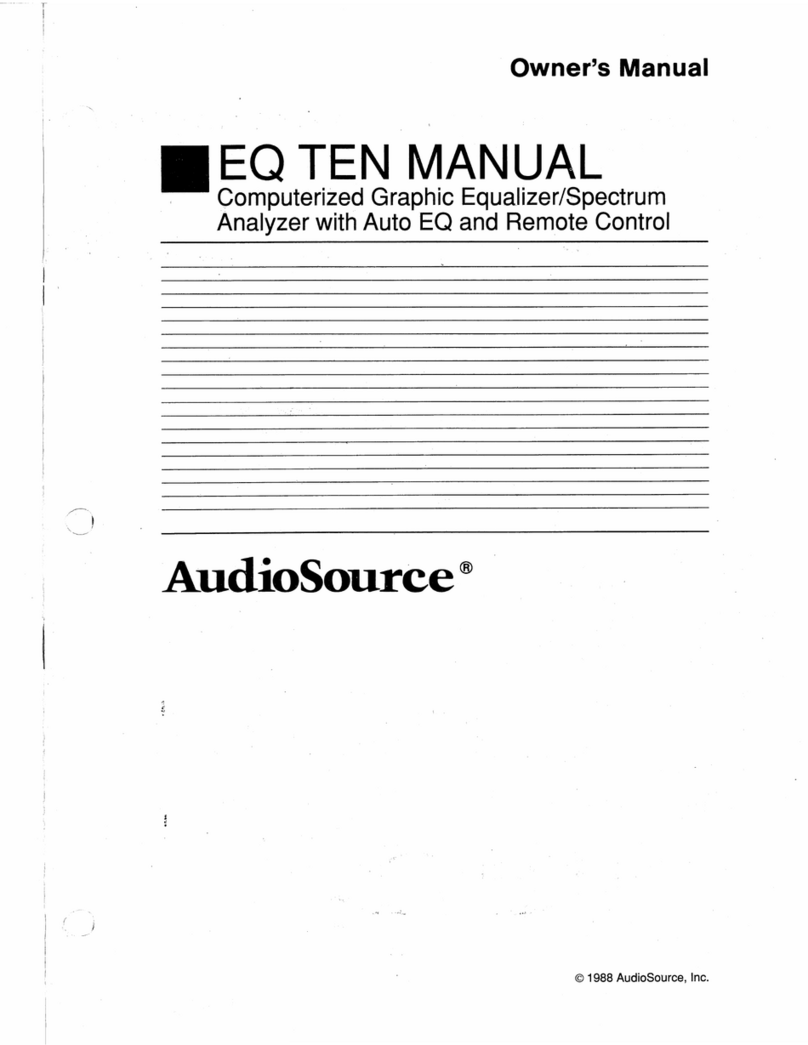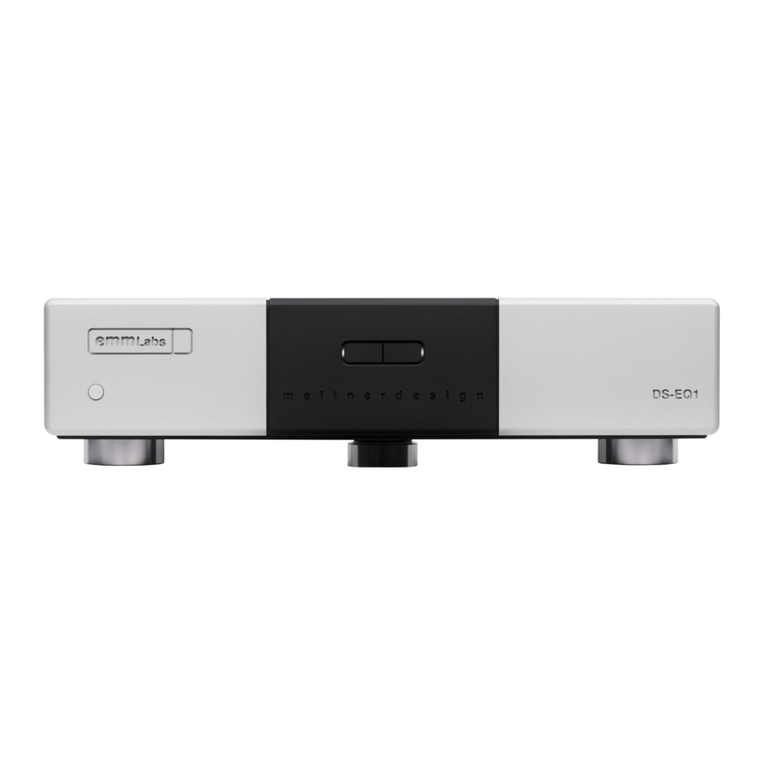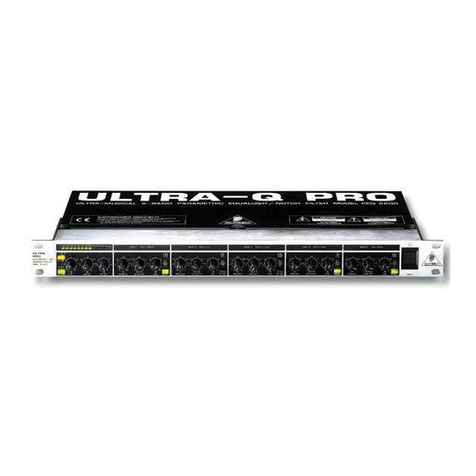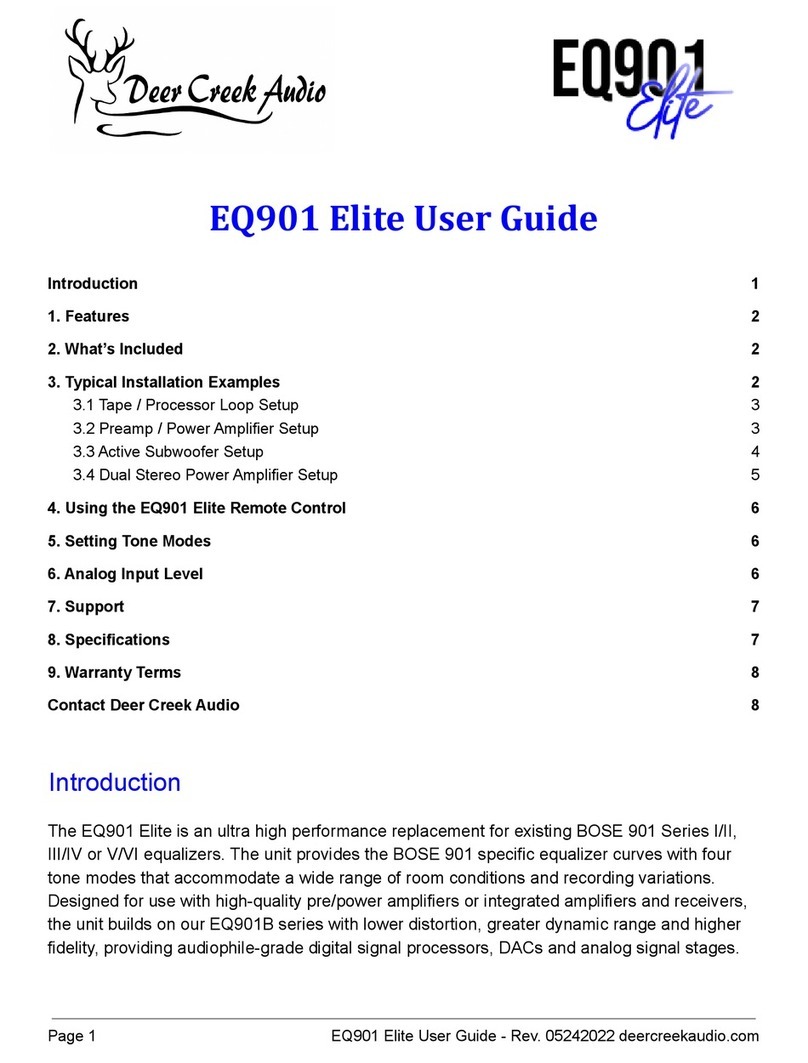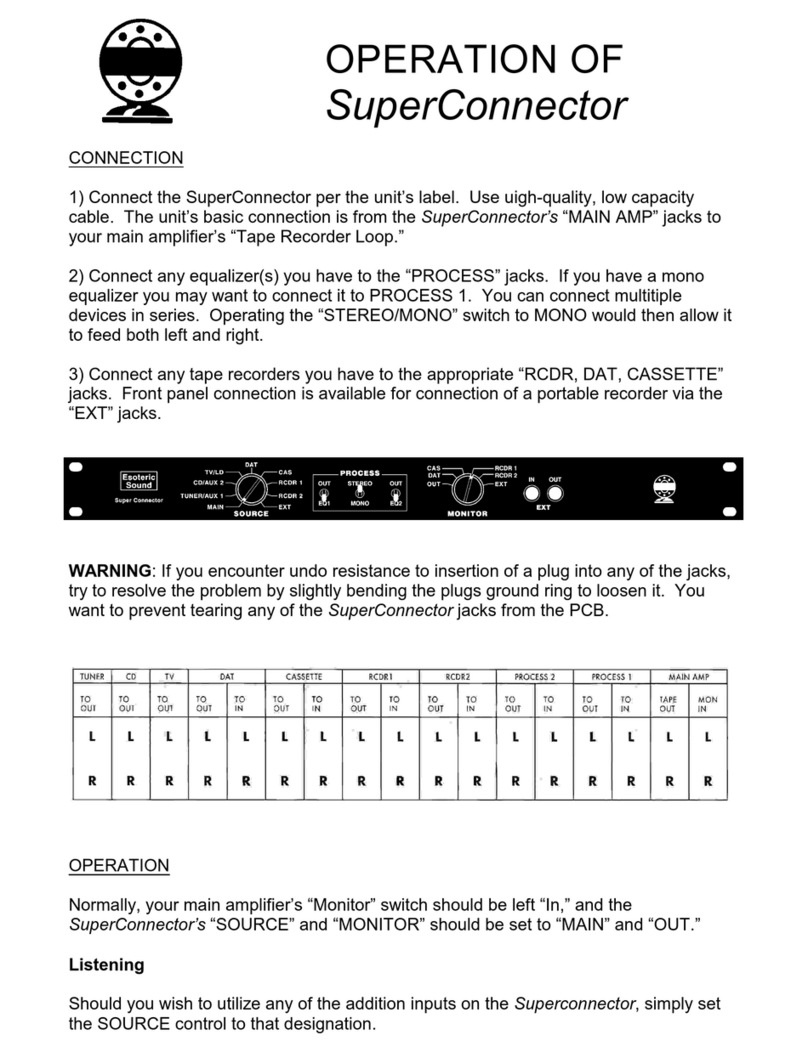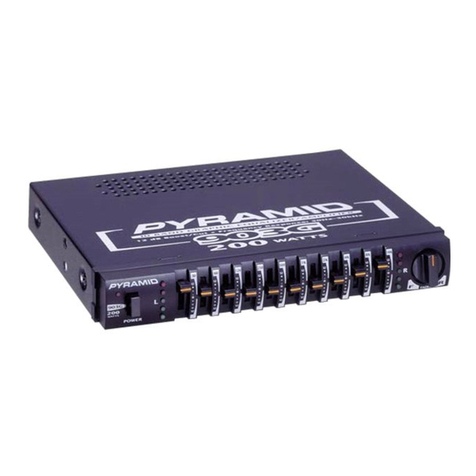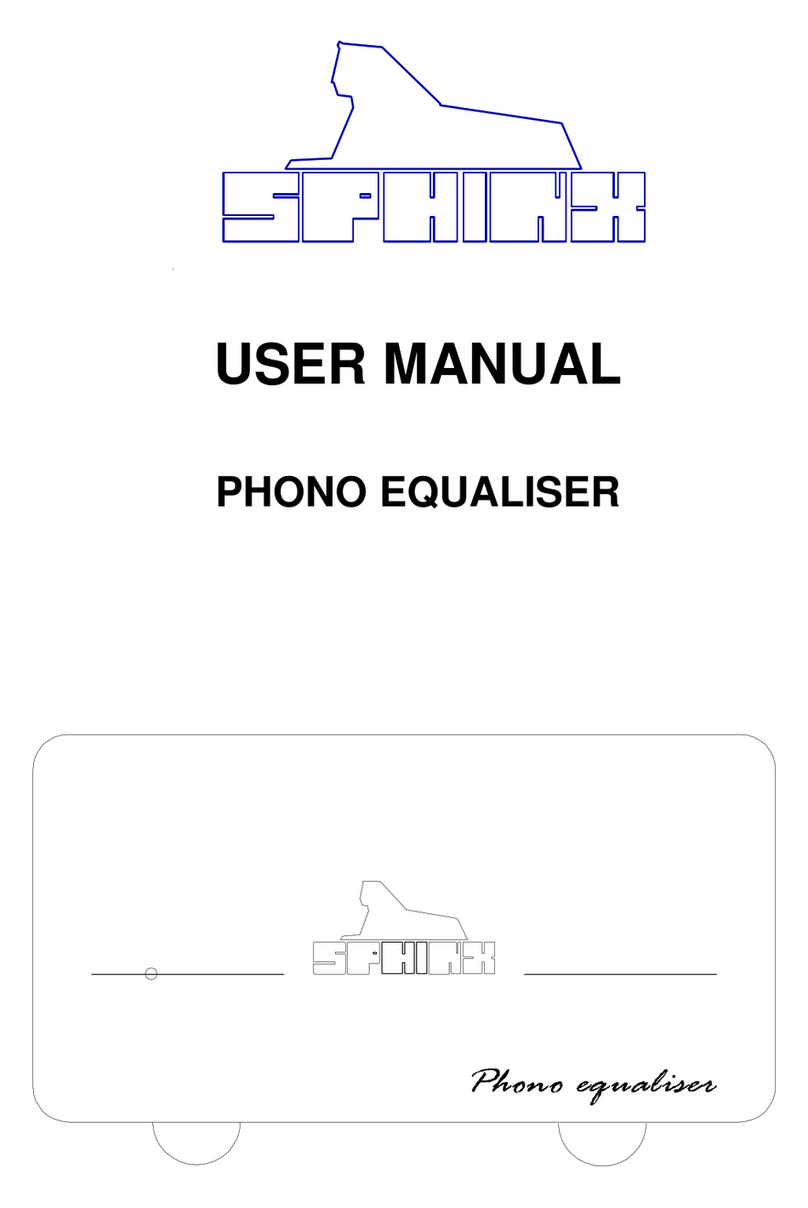Sebatron SPIDER EQ User manual

~Sebatron~
Innovative Australian Audio
SPIDER EQ - operating manual
Copyright Sebatron 2023

Two Channel Class A Transformerless Valve EQ
SPIDER
1/Introduction
2/Features
3/Functions and Dials
4/Inputs and Outputs
5/Operation
6/General Maintenance
7/Specifications
Table of Contents:

The Sebatron Spider EQ is a high quality Two Channel Class A
Transformerless Valve Equalizer housed in a 2U rack chassis designed for
tracking, mixing or mastering purposes.
Both channels of the Spider EQ feature upper and lower shelf bands
each with two selectable frequencies and two mid bell bands each with
four selectable frequencies to suit your audio equalization requirements.
Each band has up to 10db of boost or cut.
The Spider signal path uses optimised discrete op amps with high
voltage transistors as input and output buffering stages. A dual-triode valve
( or Vacuum Tube ) supplies the processing gain for the equalizer circuit.
All circuitry is Class A and operated in single ended mode to provide
maximum musicality with absolutely no cross-over distortion. The high
voltage supply rails ensure massive headroom for boosts or cuts and
minimize the possibility of noise and distortion. The bypass is relay driven
to guarantee no signal colouration when the unit is switched out of the
signal path.
Visual signal monitoring for the audio signals is provided by two
back-lit VU meters for accuracy and ease. The meters have a +4db or
+8db switchable operating point to aid with the monitoring of heavier
signals without slamming the meter.
In use the Spider is an incredibly useful tool as it enhances almost
any source material that is put through it. The extra harmonics generated
within the valve give the signal increased width, depth and definition.
It can take an ordinary sounding mix to a new level by taming the
frequencies that need to be tamed and pushing the frequencies that matter
the most.
1. Introduction

2. Features

-Full relay driven bypass
-Rugged discrete solid-state Class A input/output buffering stages
-Two twin-triode valves running on high voltage and DC filament
supplies
-Four bands ( two outer shelves and two mid bells ) of active valve
equalization
-10 db approx. boost or cut per band
-LOW switchable 40hz/80hz shelf 6db per octave
-LOW-MID wide ‘Q’ switchable 160/220/360/500hz frequency bands
-HIGH-MID tight ‘Q’ switchable 1.2k/2.2k/4k/5khz frequency bands
-HIGH switchable 8khz/14khz shelf 6db per octave
-Variable and transparent output gain
-
Accurate two channel VU metering with backlit globes
-Accurate two channel VU metering with backlit globes-
-Switchable +4db/+8db output range metering
-Fully balanced XLR inputs and outputs
-Low noise and wide bandwidth specifications
-Switchable 115/230 VAC mains operation
-High quality components and parts used throughout
-Solid and durable build housed in a 2U rack chassis
2. Features
-Full relay driven bypass
-Rugged discrete solid-state Class A input/output buffering stages
-Two twin-triode valves running on high voltage and DC filament
supplies
-Four bands ( two outer shelves and two mid bells ) of active valve
equalization
-10 db approx. boost or cut per band
-LOW switchable 40hz/80hz shelf 6db per octave
-LOW-MID wide ‘Q’ switchable 160/220/360/500hz frequency bands
-HIGH-MID tight ‘Q’ switchable 1.2k/2.2k/4k/5khz frequency bands
-HIGH switchable 8khz/14khz shelf 6db per octave
-Variable and transparent output gain
Accurate two channel VU metering with backlit globes
-Switchable +4db/+8db output range metering
-Fully balanced XLR inputs and outputs
-Low noise and wide bandwidth specifications
-Switchable 115/230 VAC mains operation
-High quality components and parts used throughout
-Solid and durable build housed in a 2U rack chassis
SPIDER EQ

The Spider EQ is equipt with two High shelf frequencies and
two Low shelf frequencies. Both shelf slopes are 6db per octave.
The Low shelf adds weight and width to a mix and the High shelf opens
up the response and adds clarity.
Each shelf band has up to 10 db of boost or cut in the desired frequency.
Interactivity between the shelf and mid bands happens when the dial is
in the dotted line range.
Low Shelf
40 HZ
80 HZ
High Shelf
8KHZ
14KHZ
3. Functions and Dials

3. Functions and Dials
The two mid bands each feature a choice of four frequencies.
The Low-Mid band has a wide bell ( or low ‘Q’ ) to facilitate wide boosts
or cuts in the lower midrange frequencies.
The High-Mid band has a narrower bell ( or high ‘Q’ ) to facilitate thinner
boosts or cuts in the higher midrange frequencies.
Each bell band has up to 10 db of boost or cut in the desired frequency.
Interactivity between the shelf and mid bands happens when the dial is
in the dotted line range.
Low-Mid ( wide ‘Q’ approx 1-2)
160 HZ
220 HZ
360 HZ
500 HZ
High-Mid ( tight ‘Q’ approx 5-6)
1.2KHZ
2.2KHZ
4KHZ
5 KHZ

Channel 1 Output/Input
Channel 2 Output/Input
Balanced XLR Balanced XLR
The Sebatron Spider is equipt with electronically balanced
XLR inputs and outputs.
All XLR inputs and outputs are :
pin 1=shield, pin 2=hot (+), pin 3=cold (-).
4. Inputs and Outputs

IEC Mains Power Input
Voltage Selector Switch
The Sebatron Spider EQ can be switched between different global
mains voltages via the Voltage Selector Switch on the back of the unit.
This switch is usually set in the factory for the appropriate voltage
that the unit is destined for, however, in cases of resale etc. it is always
recommended to check this switch before initial power up.
If the Voltage Selector Switch is set to the wrong position the fuse
should blow before any damage occurs. This situation would occur
when the switch is set to 115VAC but the input voltage is 230VAC.
Fuse rating is 0.8 amp @ 240/250 volts ( or 1.6 amp @ 110/120 volts ).
4. Inputs and Outputs

For best operation it is recommended that the Sebatron Spider EQ is
connected to a balanced output and fed by fully balanced signals rated at
the +4db nominal standard operating level.
To confirm the signal is in the right range refer to the VU metering to
ensure that the signal does not exceed the scale which could cause
distortion nor does the signal remain in the lower region of the VU meter
which could make it become prone to being noisy.
Once you have connected the Spider EQ to a suitable signal source
and confimed the range is within the range displayed on the VU meter then
you can follow the procedure below :
1.Set all bands and shelves to flat - noon position on each of the frequency
band dials
2.Set Low-Mid band frequency selector to 160 hz and High-Mid band fre-
quency selector to 1.2khz
3.Flick between bypass and active using the bypass/active toggle switch
and match the two levels in loudness using the output level control
4.Proceed to adjust Equalizser bands to taste keeping in mind to adjust the
output level control to maintain the output signal in the desired processing
range and from clipping the next unit the Spider EQ is plugged into
5. Operation

6. General Maintenance
Valves and valve type :
The Sebatron Spider EQ is fitted with two J.J 12AT7 ( ecc81 ) twin triode valves .
We recommend using J.J valves where possible as they are the most consistent valve
being manufactured at the moment.
Other brands recommended include Mullard , JAN , Phillips .
If a slightly more coloured response is desired the Spider EQ can be used with 12AX7
( ecc83 ) valves with little or no calibration required.
Channel matching calibration :
Sometimes it is difficult to source two exactly equal valves in terms of gain.
To match the two channels in gain there are internal trimpots that allow up to +/- 4db of
gain to be calibrated if it is required to match valves of different gain or to counteract
any gain drift between the valves due to age or wear.
To match the gain of the two channels with each other set all dials to flat
and the output level to noon or mid-way.
Send the Spider EQ a 1khz sine wave equally to both channels
and adjust the internal trimpots so that both channels exhibit the same output level
on the VU meters.
VU calibration :
To facilitate VU calibration the Spider is equipt with a VU meter driver board with
an adjustable trimpot allocated to each channel.
To calibrate the VU meters simply send the Spider EQ a 1khz sine wave balanced
signal at +4dbu ( or 1.23VAC between pins 2 and 3 ), flick the channel into active mode
with all EQ levels set to flat and adjust the internal VU calibration trimpots
on the VU driver board ( loacated near the mains switch ) so that the VU meters read
0dbVU.

6. General Maintenance
Warm up period :
For the valves to settle in and voltages to stablize we recommend a brief
warm up time of 2 to 4 minutes.
General Use :
The Sebatron Spider EQ comes stocked with brand new J.J valves.
We use J.J valves because of low microphony, consistency and of course the
sound which is generally regarded as neutral.
Valve life varies from valve to valve but is generally three to five years with
average useage and up to ten years if used sporadically and kept in a good
environment. As valves approach the end of their lifespan there usually is a rise
in noisefloor (hiss-noise) and a narrowing of the sonic bandwidth.
If useage is minimal and within 10 hours a week on average, then we
would recommend valve replacement around the four to five year mark. Heavier
useage, twenty hours a week and upwards for example, we would recommend
valve replacement within three years.
In all cases useage is simply having the unit on, not necessarily passing
signals. Even in an idle state with no signals there are valves operating and it is
recommended that for general useage that the unit be left on for periods of no
longer than eight hours at a time. If longer periods are required it is recommend-
ed that the unit be switched off for at least half an hour for some cooling to occur
before proceeding with the next shift.
Precautions :
- Do not operate unit in moist or wet enviroments
- Avoid moisture and excessive heat
- Do not remove lid when mains power cord is connected
- Always replace with same type of rated or recommended fuse
- Operating temperature range : 0C to +50C approx
- To prevent the risk of electric shock, do not operate with lid removed
- Do not expose to dripping or splashing and do not place objects filled with
liquids, such as vases, on top of the unit
- For proper safety, the unit must be connected to a mains socket outlet with a
protective earthing connection
- Unit is live even when switched off. Indicator lamp beside the on switch does
not mean the apparatus is disconnected from the mains
- To disconnect completely from the mains supply cable needs to be removed
from the apparatus
- The mains power disconnect device for apparatus is the appliance coupler on
the rear of the apparatus and shall remain readily operable
- No user servicable parts inside. Refer service to qualified personel
- Refer to manual illustration for input and outputs connect

Valve Type : 12AT7/ECC81 or 12AX7/ECC83
( two valves required - matched if possible )
Prefered Valve Brand(s) : J.J, Amperax, Telefunken, JAN
Low Shelf Band : switchable 40hz , 80hz
High Shlef Band : switchable 8khz , 14khz
Low-Mid Band : switchable 160hz,220hz,360hz,500hz
High-Mid Band : switchable 1.2khz,2.2khz,4khz,5khz
Frequency Response : 20Hz - 80 KHz +/- 2db
Maximum Input level : +20dbu
Maximum Output Level : +30dbu
Total Harmonic Distortion : 0.01% to 0.1%
Signal to Noise Ratio : -105 db
Output Impedance : Less than 600 ohm
Service/Repair queries:
Power : Externally switchable 110/120/220/240 VAC for global useage
Build : 2U Chassis is 1.2mm mild steel powder coated ‘Textured Black’
Front Panel : 3mm mild steel powder coated
Modular P.C.B : Easy servicing and modifications
Topology : Discrete and Class A Valve and Solid State signal path
running on +300V and +60V rails respectively
Circuitry : Class A Discrete and low noise
Two Dual Triode 12AT7/ecc81 and High Voltage Silicon Transistors
7. Specifications



